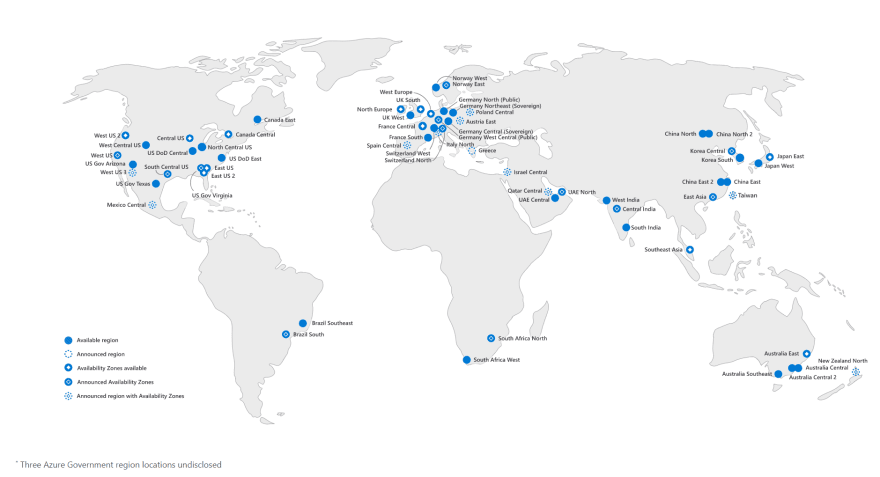World map of Azure Regions, Oct 2020
This huge footprint results in a potentially overwhelming choice of locations to spin up and run services globally, so here we will learn the meaning of the common terms Region and Availability Zone.
Regions in Azure refer to the approximate physical locations data centers exist. All Regions are made up of Availability Zones, which are singular and independent data centers.
What's a Region?
A set of data centers deployed within a latency-defined perimeter and connected through a dedicated regional low-latency network.
Definition from Azure docs [here]
Put simply, an Azure Region is a collection of several Azure Availability Zones within a given geographic region.
Azure Regions, whilst listed geographically, are officially defined as being within a 'latency-defined perimeter'. This, in short, means data centres within a region must have a network speed below a limit internally defined by Microsoft, on the regional low-latency network --- a high-speed fibre link between all data centres within the region.
What's an Availability Zone?
Unique physical locations within a region. Each zone is made up of one or more data centers equipped with independent power, cooling, and networking.
Definition from Azure docs [here]
Availability Zone refers to unique data centres within a given region.
These Availability Zone data centres operate independently from other Availability Zones within the same region: having their own power, cooling and networking. Multiple Availability Zones are offered within regions to allow redundancy for regional deployments. Because each Availability Zone operates independently and has its own unique infrastructure, if one data centre were to fail, odds are others in the same region wouldn't --- maintaining your uptime and offering a fallback.
The use of Availability Zones is optional, and mostly exists for larger scale apps and where high uptime is a priority. Microsoft commits that updates and maintenance within a given region will be staggered between Availability Zones within a given region to maintain the high availability.
Whilst it may be acceptable for your needs at first, as projects grow --- both in size and importance --- it is a good practice to mirror resources and divide different resources between Availability Zones within the same region to benefit from multiple physical locations with minimum impact on latency.
What are Paired Regions?
Paired Regions are two separate regions in a single Geography, typically the same nation or population centre.
Azure considers regional pairs when planning updates, maintenance and in the event of outages. In these cases, maintenance will be performed in one region first whilst the other remains fully operational and vice versa. Moreover, in the event of disaster, Microsoft will prioritise recovery in one of the two Regions first. This can be exploited to maintain uptime and resilience by creating resources in both Regions of a Paired Region.
Originally published at https://certifriedit.com on October 30, 2020.




Top comments (0)